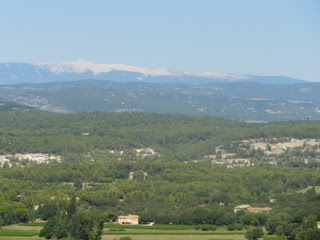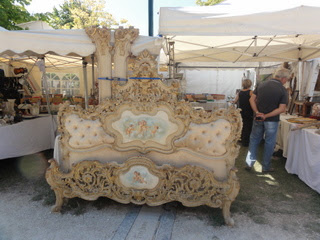Provence
One of the things that I like about Provence is the diversity of the landscape.
We have been to lots of places and they're all all different. Here are some of them.
Vaison la Romaine is a village in the north of Provence. It has a 2,000year old Roman bridge which is still in use and even survived a major flood in the 1970s. It also has a lot of Roman ruins - some of which have been relatively recently discovered.
We walked up to this medieval castle which gave a great view of the surrounding area.
On the way up we saw this man working 2 stories up with no safety equipment. Don't know the law here but it would be highly illegal in Australia.
Good place for a sketching group.
I really liked this photographic exhibition that was scattered around the medieval area and seemed to be of the history of the town.
We went to a small market in a town under Mont Ventoux and met this lovely lady - Martine who makes jewellery. She studied gemmology in Thailand and had some very interesting stones. She and Bob did a deal so I'll look out at Christmas!
Another day we went to Aix-en-Provence. It is quite a sophisticated city and the home of the painter Paul Cezanne. They make a lot of this although when Cezanne was painting the curator of the museum in Aix-en-Provence thought Cezanne was an untalented upstart and refused to buy any of his work so they do not have any to display now.
Children will always play in fountains.
and get married
and relax in nice cafes under the trees on a hot day.
Mont Ventoux ever in the background.
In nearby Lacoste Pierre Cardin has bought the castle, once owned by the Maquis de Sade, and is renovating it. He has also bought several other deserted buildings and turned them into cafes and B and Bs. This has provided employment to several people. The village is divided over whether it's a good thing or not and many have successfully opposed and prevented his efforts to build a golf course on deserted land nearby which he believes would bring more visitors to the area.
So then to Orange where there's an old Roman amphitheatre. It was deserted for centuries and a lot of the statues etc were destroyed in the French Revolution but it's been restored and is still used for concerts today. They were preparing for one when we were there. Apparently the Romans knew a lot about acoustics and the sound in this amphitheatre is considered remarkable even by todays standards.
Avignon.
This is the Papal Palace in Avignon where 7 Popes resided from 1309 - 1378. This happened when a French Pope - Clement V was elected after a long impasse in Rome. He refused to move to Rome and moved to the papal enclave in Avignon. When the Papacy returned to Rome in 1378 after disunity in the Church alternative illegitimate popes set up in Avignon until 1417 creating a Western Schism.
There are two buildings - the old and new Palais. It was built as a fortress and Palace and is huge because many people worked and lived there.
The main attraction today is it's size. There is very little furniture or relics from the past. Still very impressive though.
Pont Saint-Benezet or Pont d' Avignon
This is the famous medieval bridge of the song fame "Sur la Pont d'Avignon." It was built between 1177 and 1185 out of stone. A local shepherd boy- later Saint-Benezet, had a vision that he should build the bridge and got the support of sponsors. He is buried in this chapel on the bridge. The bridge had great strategic importance when it was built as it was the only fixed crossing of the Rhone between Lyon and the Mediterranean. Parts of it have collapsed in flooding and been rebuilt and now only 4 of the original 22 arches remain.Fontaine-de-Vaucluse
One of my favourite places was the small village of Fontaine-de-Vaucluse just a few kilometres from Isle sur la Sorgue. It is named after the spring that is the source of the Sorgue River which is at the base of this 230 metres high cliff.
The source of the river is underground and despite numerous attempts over the years it's exact source has never been found. It flows more when it has been raining but it was amazing to see the dry stones above and then, as in the last photo, large amounts of water coming from seemingly nowhere and flowing downstream. It provides all the water around Isle sur la Sorgue.
After the defeat of France by Germany in 1940 the country was divided into an occupied and unoccupied zone. The south, including Provence, was governed by the French Vichy Government and this area was not occupied by the Germans until 1942. The Vichy Government was ultra conservative and participated in sending Jews to concentration camps of their own accord. This was kept secret after the war and it took many years for some of the Vichy officials to be charged. France is still coming to terms with this relatively recent part of their history today.
There was also an active resistance movement during this very difficult time in French history.



























































